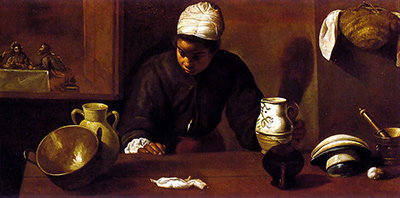The Kitchen Maid is believed to have been painted in 1618 and even though this is one of the earliest works by Velazquez, the maturity and expertise which surpassed that of Pacheco is obvious and exquisite, both in the realistic quality of the components within the painting as well as the natural moment which has been perfectly captured, almost like a snapshot.
There are a number of notable aspects of this painting, perhaps the most striking of which is the similarity in style to the work of Caravaggio, whose masterful use of chiaroscuro was characteristic of his paintings and The Kitchen Maid can justifiably be compared to his works.
Velazquez believed in the realism of objects and people, able to capture life-like situations where the viewer unquestionably accepts what they are seeing because of the realistic portrayal of scenes and the characters within them.
Some schools of thought regarding The Kitchen Maid suggest that there is symbolic significance of the composition where a humble kitchen servant is depicted before a painting of a divine miracle of Christ.
The heavy use of highlight and shadow creates a solidity to the kitchenware on the table so that the viewer understands the weight and texture of the objects. Even the patina on the table itself provides a tangible quality to the wood.
The female Moorish kitchen servant is treated with sensitivity as Velazquez delicately defines her features with a softer light falling across her face compared to the harsher contrasting brightness which picks out the white of the fabrics and the shine on the pottery.
The overall use of tone by Velazquez binds the whole piece together as the colour palette ranges through browns, ochres and umbers across the entire painting, but the splashes of brightness add dimension and balance without looking artificial.
One of the most interesting features in this painting is the picture on the wall behind the kitchen maid, which depicts the supper at the house of Emmaus. Religious themes were extremely popular for commissions so it would not be unusual for these types of paintings to be on the walls of a house, and Caravaggio’s Supper at Emmaus is arguably one of the most famous paintings of this type.
Whilst the painting depicted on the wall is not Caravaggio’s, it is similar and also interesting that it is featured in this painting by an artist whose style is so comparable to Caravaggio.
Diego Velazquez was a Spanish painter from Seville. Born in 1599, his extraordinary artistic potential quickly earned him scholarship under the most respected painters of the time, most notably Francisco Pacheco, to whom Velazquez was apprenticed until 1617.




